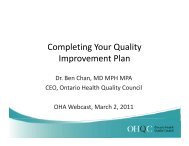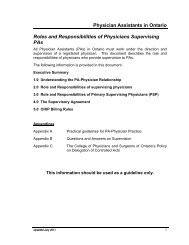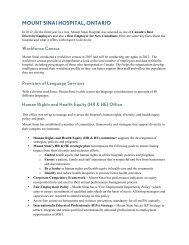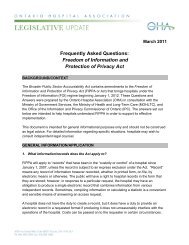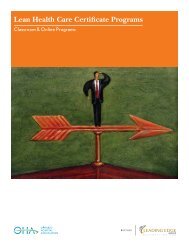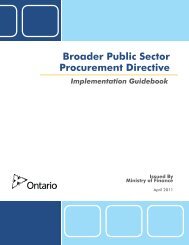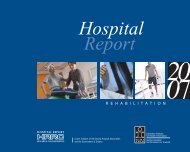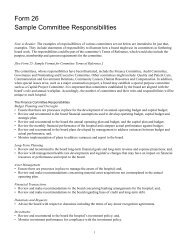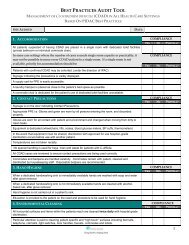Bending the Health Care Cost Curve - Ontario Hospital Association
Bending the Health Care Cost Curve - Ontario Hospital Association
Bending the Health Care Cost Curve - Ontario Hospital Association
- No tags were found...
You also want an ePaper? Increase the reach of your titles
YUMPU automatically turns print PDFs into web optimized ePapers that Google loves.
Ideas and Opportunities for<strong>Bending</strong> <strong>the</strong> <strong>Health</strong> <strong>Care</strong> <strong>Cost</strong> <strong>Curve</strong>Advice for <strong>the</strong> Government of <strong>Ontario</strong>April 2010
Toge<strong>the</strong>r, we represent a group of provider associations committed to building a better healthsystem:• The <strong>Ontario</strong> <strong>Association</strong> of Community <strong>Care</strong> Access Centres (OACCAC);• The <strong>Ontario</strong> Federation of Community Mental <strong>Health</strong> and Addiction Programs (OFCMHAP)and;• The <strong>Ontario</strong> <strong>Hospital</strong> <strong>Association</strong> (OHA).
TABLE OF CONTENTSIntroduction ........................................................................................................................................ 31. HBAM 1% Investigative Project ................................................................................................... 52. Province-wide Implementation of <strong>Ontario</strong>’s Existing Chronic Disease Prevention andManagement Framework ................................................................................................................... 63. Implementation of Leading Practices in Targeted Areas ............................................................... 93.1 Provision of Continuing <strong>Care</strong> in <strong>the</strong> Most Appropriate Location.......................................... 103.2 Adoption of Leading Practices for Wound <strong>Care</strong> .................................................................... 133.3 Adoption of Leading Practices for Palliative <strong>Care</strong> ................................................................ 153.4 Increased Management of Mental <strong>Health</strong> and Addiction Issues in <strong>the</strong> Community ............. 163.5 Adoption of a Business Case Approach for Error Reduction Strategies ............................... 183.6 Expansion of Leading Practices for Supply Chain Management .......................................... 214. Management of Expenditure on Physician Services .................................................................... 235. Management of Expenditures on Drugs ...................................................................................... 256. Implementation of Selected <strong>Hospital</strong> Human Resource Initiatives ............................................. 26Summary of Recommendations and Estimates of Potential Savings ........................................ 29AppendixesAppendix 1.1: <strong>Ontario</strong> Government Budget Deficit ...................................................................... 1Appendix 1.2: <strong>Ontario</strong> Provincial Government Expenditure on <strong>Health</strong> <strong>Care</strong> ............................... 2Appendix 1.3: <strong>Ontario</strong> Provincial Government Expenditure on <strong>Health</strong> <strong>Care</strong> Per Capita ............. 3Appendix 1.4: <strong>Ontario</strong> Gross Domestic Product ........................................................................... 4Appendix 1.5: <strong>Ontario</strong> Provincial Government <strong>Health</strong> Expenditures per Capita, by Type .......... 6Appendix 1.6: Expenditure on Physician Services: <strong>Ontario</strong> vs. O<strong>the</strong>r Provinces ......................... 7Appendix 1.7: Expenditure on Drugs: <strong>Ontario</strong> vs. O<strong>the</strong>r Provinces ............................................. 8Appendix 1.8: Expenditure on <strong>Hospital</strong>s: <strong>Ontario</strong> vs. O<strong>the</strong>r Provinces ........................................ 9Appendix 1.9: Expenditure on O<strong>the</strong>r Institutions: <strong>Ontario</strong> vs. O<strong>the</strong>r Provinces ......................... 10Appendix 2.0 <strong>Ontario</strong> <strong>Health</strong> <strong>Care</strong> <strong>Cost</strong> Distribution .................................................................. 112
Introduction<strong>Ontario</strong>’s health care system, like any o<strong>the</strong>r, has always been under pressure to meet growingdemands with constrained budgets. For government and providers alike, <strong>the</strong> continued pursuit ofhigher quality, greater access and newer treatments means <strong>the</strong>re is always more to do. A stronghealth care system requires ongoing investment in improvements and modernization.Within <strong>the</strong> current economic environment however, <strong>the</strong> task of meeting Ontarian’s health careneeds has become even more challenging. With a projected provincial deficit of $21.3 billion for2009, slower economic growth and lower tax revenues, <strong>the</strong>re is a reduced capacity to maintaincurrent rates of health care spending. As <strong>Ontario</strong> continues through this period of restraint, <strong>the</strong>re isa great need to find new ways to operate more efficiently—getting greater value for money—andalso to “bend <strong>the</strong> cost curve”.In <strong>the</strong> past decade, <strong>the</strong> <strong>Ontario</strong> government’s health expenditure cost curve has grown by anaverage of 7.7% per year. 1 The major categories of expenditures have grown on average, asfollows: hospital expenditures by 6.5 % per year; physician expenditure by 7.8 % per year; drugexpenditure by 9.2 % per year; public health by 12.7 % per year; and o<strong>the</strong>r institutions includinglong term care homes by 7.2 % per year.In dollar terms, total <strong>Ontario</strong> government health expenditure has doubled from $21.6 B in 1999 toa forecasted $45.2 B in 2009. Although <strong>Ontario</strong>’s per capita spending is <strong>the</strong> second lowest in <strong>the</strong>country, next to Quebec, this measure has increased from approximately $1,900 to $3,500 perperson (84%). In comparison, over <strong>the</strong> same time period, <strong>Ontario</strong>’s GDP grew much less, at 39%(from $409 billion to $570 billion) even with high growth rates occurring prior to <strong>the</strong> economicdownturn.There are many ways in which <strong>the</strong> system can respond to current fiscal realities. It must berecognized however, that while <strong>the</strong>re are pressures to find short-term solutions, <strong>the</strong>re are few quickand easy ideas left. There is currently no option but to take a primarily longer-term view in order toyield lasting results. In an effort to put forth effective solutions for <strong>Ontario</strong>, this report provides asampling of several ideas and opportunities to enhance value and reduce costs in <strong>the</strong> short, mediumand longer-terms.These ideas represent areas identified as good prospects, have been brought to light through newdata or are examples of current initiatives that could be expanded. They include: swiftimplementation of leadership and strategies to better manage costly chronic illness; rapid uptake ofresults-oriented leading practices; appropriate shifting of services and funding from hospitals to <strong>the</strong>community; management of expenditure on physician services and drugs to move towards <strong>the</strong>significantly lower levels attained in o<strong>the</strong>r provinces; targeted human resource initiatives ando<strong>the</strong>rs.1 See appendixes for a series of data charts.3
High level estimates of <strong>the</strong> potential for cost savings are provided. In <strong>the</strong> absence of moredetailed information, some estimates are “order of magnitude” calculations. O<strong>the</strong>r estimatesrepresent <strong>the</strong> opportunities identified through comparisons with spending patterns in o<strong>the</strong>rprovinces. Given <strong>the</strong> range of possibilities for achieving savings, <strong>the</strong> investments needed toadvance <strong>the</strong>se initiatives have not been specifically identified within <strong>the</strong> overall estimates ofsavings. As <strong>the</strong>re is some overlap of initiatives, in order to avoid double counting, dollarsavings should not be summed.Some may question <strong>the</strong> focus on cost savings when non-financial outcomes—lives saved, betterhealth and quality of life, greater safety, shorter waits—are <strong>the</strong> results that matter. These are ofcourse, <strong>the</strong> aims of delivering high quality health care in <strong>the</strong> first place. When funding is tight,however, even practices with substantial health benefits may not gain traction if <strong>the</strong>y are viewed asunaffordable new expenses. By taking a “business case” approach that provides a clear return-oninvestment,decisions to implement new initiatives that pay for <strong>the</strong>mselves—ei<strong>the</strong>r within anorganization or between organizations—can easily proceed.By supporting <strong>the</strong> initiatives outlined here, <strong>the</strong> Government of <strong>Ontario</strong> can build on its track recordof addressing complex challenges. As evidenced by <strong>the</strong> Wait Times Initiative and o<strong>the</strong>r systemicTransformation projects, government clearly recognizes <strong>the</strong> importance of holding a vision of <strong>the</strong>system for <strong>the</strong> short, medium and longer-term, and of considering cross-sectoral impacts. Ourhealth care system has never stood still. With leadership and collaboration, and a focus on lastingresults, we can achieve what is necessary to ensure a high quality, affordable system in years tocome.4
1. HBAM 1% Investigative ProjectWith <strong>the</strong> development of <strong>Ontario</strong>’s <strong>Health</strong> Based Allocation Model (HBAM) through <strong>the</strong> Ministryof <strong>Health</strong> and Long-Term <strong>Care</strong> (MOHLTC), it is now possible to conduct new analysis about <strong>the</strong>costs, quantities and distribution of health care services. Summary-level HBAM data have beenpresented publicly in various health care forums. A key finding revealed through <strong>the</strong> data is that agreat deal of <strong>Ontario</strong>’s health expenditures are concentrated among a small proportion of <strong>the</strong>population. Specifically, on an annual basis:• 1% of <strong>the</strong> population accounts for 49% of combined hospital and home care costs;• 5% of <strong>the</strong> population accounts for 84% of combined hospital and home care costs. 2The HBAM dataset can be drilled down to very specific service types and patient groupings toidentify opportunities to improve quality and cost in targeted areas. For example, within <strong>the</strong> highuse“one percent” population, <strong>the</strong> top three acute care service categories are: circulatory;neoplasms and; injury and poisoning. Within each of <strong>the</strong>se categories, fur<strong>the</strong>r specificity ispossible, enabling <strong>the</strong> identification of groups with high hospital re-admission rates and o<strong>the</strong>roccurrences as measured by quality-related indicators.A comprehensive, provincial-level analysis using HBAM data would be a fruitful step in findingprocess improvements across <strong>the</strong> system with <strong>the</strong> potential for a large payoff of quality andefficiency. By focusing on sub-populations within <strong>the</strong> one-percent group it will be possible tostreamline and integrate care and to develop better prevention and management programs. It willno doubt be possible to reduce <strong>the</strong> need for expensive hospital utilization.<strong>Cost</strong> Saving Potential:For 2009, <strong>the</strong> forecasted expenditure on hospitals by <strong>the</strong> <strong>Ontario</strong> government is $16 billion for atotal population of 13 million 3 . If roughly half of this expenditure is attributed to 130,000 people<strong>the</strong>n significant opportunities exist to achieve savings on $8 billion 4 using specific, focusedinitiatives.Every 10% reduction on <strong>the</strong> $8 billion expenditure used by 1% of <strong>the</strong> population equals $800million in savings.If expenditures can be reduced by:<strong>the</strong> potential savings are:5 % $400 Million10 % $800 Million20 % $1.6 Billion2 See Appendix 2.0.3 Canadian Institute for <strong>Health</strong> Information, National <strong>Health</strong> Expenditures Database 2009.4 This excludes possible savings in areas such as for physicians or drugs, currently excluded from HBAM.5
Recommendation:The MOHLTC should conduct a comprehensive analysis of service utilization, at <strong>the</strong> level ofspecific patient categories in order to select key priorities for implementing new initiatives wi<strong>the</strong>xpected financial and non-financial benefits.Every 10% reduction on <strong>the</strong> $8 billion expenditure used by 1% of <strong>the</strong> population equals$800 million in savings.2. Province-wide Implementation of <strong>Ontario</strong>’s Existing Chronic DiseasePrevention and Management FrameworkChronic Disease has a Major ImpactChronic disease is widely recognized as <strong>the</strong> major cause of world-wide death and disability. TheWorld <strong>Health</strong> Organization (WHO) projects that in Canada, in <strong>the</strong> next decade, a large proportionof all deaths will be caused by a chronic condition: 34% of all deaths will be caused bycardiovascular disease; 29% will be caused by cancer; 17% will be caused by “o<strong>the</strong>r chronicdiseases”; 6% will be caused by chronic respiratory disease and; 3% will be caused by diabetesalone. The economic impact is estimated at over $9 billion over a decade, when measured in termsof lost productivity to <strong>the</strong> Canadian economy, health system costs and costs borne by individuals. 5In <strong>Ontario</strong>, a large and growing number of people live with a chronic condition. Seventy percent of<strong>the</strong>se Ontarians have at least two chronic conditions. 6 As well, depression is not uncommonamong those coping with ongoing health conditions.Chronic Disease Prevention and Management has Many FacetsElements of prevention and chronic disease management (CDM) extend well beyond simplyreceiving treatment in <strong>the</strong> traditional sense, through <strong>the</strong> health care system. These elementsinvolve: substantial patient education and self-management; wide-spread use of standardizedprotocols; public health initiatives; information systems including electronic health records; andperformance monitoring to track results in terms of health outcomes and health system impact.<strong>Ontario</strong>’s Existing Framework for Chronic Disease Prevention and ManagementIn recognition of <strong>the</strong> well-known fact that prevention and proper management of chronic disease ishighly cost-effective, <strong>the</strong> MOHLTC published a Chronic Disease Prevention and ManagementFramework in 2007 to improve chronic illness outcomes and to reduce costs.5 World <strong>Health</strong> Organization. http://www.who.int/chp/chronic_disease_report/media/canada.pdf .6 Ministry of <strong>Health</strong> and Long-Term <strong>Care</strong>. Preventing and Managing Chronic Disease: <strong>Ontario</strong>’s Framework, May2007. http://www.health.gov.on.ca/english/providers/program/cdpm/index.html#1 .The Framework describes <strong>the</strong> many benefits of Chronic Disease Prevention and Management.6
The Ministry’s Framework is a good one. It is based on <strong>the</strong> highly respected U.S. Chronic <strong>Care</strong>Model which has been widely adopted internationally. An expanded version is being applied inBritish Columbia, Alberta, Saskatchewan and Manitoba.Some Incremental Progress is Occurring, More is NeededThe Framework clearly articulates aspects and key requirements of prevention and CDM. As <strong>the</strong>health care system continues to proceed through its Transformation, certain components of <strong>the</strong>Framework are underway. For example, those with chronic illness should benefit from initiativessuch as <strong>the</strong> formation of Family <strong>Health</strong> Teams. Local <strong>Health</strong> Integration Networks (LHINs) areconsidering approaches that are consistent with or specifically aimed at implementing a chronicdisease management strategy. 7 Public health initiatives and patient education programs are also inplace for certain disease areas. A diabetes strategy involving development of an on-line registryand new funding for education and equipment has been initiated. As well as new initiatives, manyorganizations have had patient programs to address particular chronic illnesses for quite sometime.Undoubtedly, positive things are happening and are making a difference in pockets of <strong>the</strong>province. However, <strong>the</strong> practice is not large-scale, wide-spread or strategic by any means. The<strong>Ontario</strong> Quality Council’s 2008 report profiles <strong>the</strong> status of CDM in <strong>Ontario</strong> and states:“Quite simply, <strong>Ontario</strong> is failing to meet <strong>the</strong> challenge of chronic disease. Close to 8,000 livescould be saved annually—and <strong>the</strong> quality of life improved for many more people—if we did abetter job of delivering <strong>the</strong> all-important regular care and monitoring that prevents <strong>the</strong>chronically ill from falling into severe bouts of illness.” 8Strong Provincial Leadership is Essential<strong>Ontario</strong> can go much fur<strong>the</strong>r. To be truly effective in targeting this large-scale issue, with widerangingimpacts, a provincial effort is needed. <strong>Ontario</strong> must get beyond <strong>the</strong> Framework phase tolarge-scale implementation. What is needed now is a major push to implement province-wideinitiatives known to be highly effective. It is <strong>the</strong> application of comprehensive practices working ina standard, coordinated way, across <strong>the</strong> entire province that will reap <strong>the</strong> greatest benefits. Strongprovincial leadership is required to make this happen.A single provincial organization with a mandate to implement a range of CDM initiatives acrossseveral chronic disease areas, as outlined in <strong>the</strong> Framework, should be created. The model ofCancer <strong>Care</strong> <strong>Ontario</strong> (CCO), due to its tremendous impact by way of a single cancer care systemfor all of <strong>Ontario</strong>, could be adopted for o<strong>the</strong>r chronic illnesses.The overlapping nature of chronic disease means that CDM initiatives should not be stand-alone orimplemented one at a time. Large benefits are possible through a single point of accountability and7 In particular, see <strong>the</strong> approach taken by <strong>the</strong> Central LHIN at http://www.centrallhin.on.ca/Page.aspx?id=9252.8 <strong>Ontario</strong> <strong>Health</strong> Quality Council. QMonitor: Report on <strong>Ontario</strong>’s <strong>Health</strong> System, 2008.http://www.ohqc.com/pdfs/ohqc_2008_report_-_english.pdf7
concentrated expertise, through one provincial organization responsible for <strong>the</strong> majority of CDM.The degree of responsibility by a provincial organization, for various aspects of CDM should bedetermined. Locally driven initiatives through LHINs, could be fur<strong>the</strong>r streng<strong>the</strong>ned anddisseminated more widely with a provincial strategy to ensure coordination.Under such a provincial structure, comprehensive programs, in addition to cancer, should bedeveloped for a range of categories of ongoing illness, including but not limited to: cardiovasculardisease; chronic kidney disease; diabetes; and chronic respiratory illness. As well, a provincialstructure should reflect an effective model to successfully transform how mental health conditionsand addictions are addressed, due to <strong>the</strong> ongoing nature of recovery in <strong>the</strong>se areas, and due to <strong>the</strong>fact that services for <strong>the</strong>se conditions cross ministry boundaries.<strong>Cost</strong> Saving Potential:The nature of chronic illness is such that <strong>the</strong> bulk of savings through CDM will occur over a periodof time. If no action is taken, however, it is a certainty that health care costs will rise to levels thatwill be considered unacceptable by most, and <strong>the</strong>re will still be unmet need.While hard data on <strong>the</strong> cost impact of specific projects is often not readily available, <strong>the</strong> potentialfor savings can be estimated using some existing calculations to assess <strong>the</strong> order of magnitude.The MOHLTC Framework document states that over a third of Canada’s direct health care costsarise from major chronic illness and injury. 9 10 Extrapolating from this statistic, using 2009 data,one third of <strong>Ontario</strong>’s direct health expenditures of $48.5 billion is $16 B. If an estimated 25% ofexpenditures can be attributed to major chronic illness (excluding injury), <strong>the</strong> figure is $12 B.Every 10% reduction on expenditures of $12 billion (attributed to major chronic illness)equals $1.2 billion in savings.If expenditures can be reduced by:<strong>the</strong> potential savings are:5 % $ 0.6 Billion10 % $ 1.2 Billion20 % $ 2.4 BillionThese figures, which consider hospital, physician, drug and o<strong>the</strong>r health care costs, areconsistent with <strong>the</strong> calculations using HBAM findings for hospital expenditure alone. Savingscalculated for CDM will overlap with savings calculated through HBAM analysis.In addition, <strong>the</strong> Ministry’s Framework document cites examples of <strong>the</strong> cost impact of chronicdisease and <strong>the</strong> economic benefits of specific strategies in various jurisdictions. In Canada: acongestive heart failure discharge program resulted in over 60% fewer hospital readmissions; aprimary care asthma intervention plan saw 50% fewer emergency visits and; an Alberta study of9 The MOHLTC’s statement references <strong>the</strong> following: Public <strong>Health</strong> Agency of Canada, “Economic Burden of Illnessin Canada”, 1998. http://www.phac-aspc.gc.ca/publicat/ebic-femc98/index-eng.php10 Direct costs are calculated using CIHI data and include expense by all levels of government (in addition to <strong>the</strong>provincial government) on hospitals, physicians, drugs, o<strong>the</strong>r institutions and o<strong>the</strong>r types of care and expenses.8
heart failure care following hospitalization reduced hospital use by 3.6 days per participant, saving$2,500 per case. As well, in <strong>the</strong> United States, a RAND Corporation study reduced hospital costsby “tens of billions of dollars” by better management of four chronic diseases: diabetes, congestive11 12heart failure, asthma and chronic obstructive pulmonary disease.Recommendations:The MOHLTC should implement its Chronic Disease Prevention and Management Strategycomprehensively, through <strong>the</strong> establishment of a single provincial organization with a mandateto implement initiatives across multiple categories of ongoing and often concurrent conditions.The MOHLTC should ensure that provincial-level leadership and coordination for chronicdisease prevention and management results in equitable access to services across <strong>the</strong> province,and streng<strong>the</strong>ned, high quality local delivery of services based on leading evidence-basedpractices.Every 10% reduction on expenditures of $12 billion (attributed to major chronic illness)equals $1.2 billion in savings.3. Implementation of Leading Practices in Targeted AreasProjects for ResultsLeading practices exist in health care for both clinical and non-clinical services. While certainmodels of chronic disease management are leading practices, suggestions and examples presentedhere represent specific practices or programs targeted to achieve a very precise result and whichmay be achievable in a shorter time period through a particular project.Again, as with CDM, various leading practices exist all over <strong>the</strong> province, across sectors, LHINsand institutions. What is lacking in <strong>Ontario</strong> is coordinated, wide-spread adoption of practices andprotocols that are known to be effective but are also known to have less than optimal usage. Forexample, some ideas which may achieve relatively quick results in <strong>the</strong> elderly population include<strong>the</strong> following:• Provision of Vitamin D/calcium supplements to long-term care residents (at less than $10 peryear per person) to ensure bone health and improve posture which would reduce fractures andcostly hospitalizations due to falls.11 Ministry of <strong>Health</strong> and Long-Term <strong>Care</strong>. Preventing and Managing Chronic Disease: <strong>Ontario</strong>’s Framework, May2007. http://www.health.gov.on.ca/english/providers/program/cdpm/index.html#1 .12 Bigelow et. al. Analysis of <strong>Health</strong> <strong>Care</strong> Interventions that Change Patient Trajectories. RAND Corporation, 2005.http://www.rand.org/pubs/monographs/2005/RAND_MG408.pdf The document, interestingly, provides acomprehensive description of <strong>the</strong> extensive process of calculating costs and benefits for a CDM program.9
• Appropriate prescribing of ACE inhibitors for diabetics to help prevent progression to endstagekidney disease thus avoiding <strong>the</strong> need for dialysis at approximately $50,000 per year.• Provision of nocturnal dialysis for long-term care residents to reduce transfers to hospital fordialysis and reduce associated risks of acquiring pneumonia during those transfers.• Expanded deployment of advance practice nurses and physician assistants to long-term carehomes to reduce transfers to hospitals.While news of excellent programs, bright ideas and recommendations are widely available across<strong>the</strong> spectrum of health care literature, dissemination of information differs from uptake. The widespreadimplementation of known good ideas requires strong, focused leadership—and frequently, abusiness case approach to decision making—to achieve.Leading Practice Expert PanelsFocused, provincial-level expert panels should be formed with <strong>the</strong> mandate to identify anddevelop ways to promote rapid and wide-spread adoption of leading practices for key areas ofclinical care, that are known to be under-utilized.In some instances this may involve “knowledge transfer” where experts disseminate knowledgeand practice of proven methods to o<strong>the</strong>r practitioners and providers in <strong>the</strong> system. In o<strong>the</strong>rinstances controlled shifts of programs between various health care sectors may be required toharvest known benefits.Recommendation:The MOHLTC should create provincial expert panels to identify and develop ways to promoterapid, wide-spread adoption of leading practices for key clinical areas with large-scale, systemicpotential for quality improvement and cost efficiencies.The items outlined below represent areas of potentially significant opportunity and includeestimates of potential savings.3.1 Provision of Continuing <strong>Care</strong> in <strong>the</strong> Most Appropriate LocationEnsuring that people who need on-going care—ei<strong>the</strong>r at home in <strong>the</strong> community or in aninstitutional setting—receive that care in <strong>the</strong> most appropriate location is a key aspect of deliveringquality, from <strong>the</strong> individual’s point of view, and in efficiently operating <strong>the</strong> health care system. Itis now well-recognized that inappropriate placement leads to system bottlenecks, excessive levelsof Alternate Level of <strong>Care</strong> (ALC) patients in hospitals, increased wait times throughout—especially longer wait times in emergency rooms—and sub-optimal care.10
While this issue requires a multi-pronged approach, <strong>the</strong> MOHLTC’s Aging at Home Strategy willplay an important role. For example, <strong>the</strong> expansion of <strong>the</strong> cross-sectoral Transitional <strong>Care</strong>programs—which include hospital-based Complex Continuing <strong>Care</strong> and Rehabilitation as well ascommunity programs –has been effective in facilitating discharge from acute care to home bymaximizing an individual’s functioning following hospitalization.It is now possible however, to fur<strong>the</strong>r leverage <strong>the</strong> Aging at Home Strategy’s benefits beyondwhat was originally envisioned. Decisions about where best to spend new monies allocated to thisprogram, can be informed through new datasets and information available through <strong>the</strong> ResidentAssessment Instrument (RAI). Funding can <strong>the</strong>n be targeted in very strategic ways to specificprograms which ensure appropriate placement, appropriate supports, better quality for individualsand at lower cost to <strong>the</strong> system. Areas of <strong>the</strong> province with <strong>the</strong> greatest expected benefits can <strong>the</strong>nbe strategically targeted for funding.To fur<strong>the</strong>r support this point, <strong>the</strong> <strong>Ontario</strong> <strong>Association</strong> of Community <strong>Care</strong> Access Centres(OACCAC) co-sponsored a project with several partners, including <strong>the</strong> <strong>Ontario</strong> Home <strong>Care</strong><strong>Association</strong>, <strong>the</strong> <strong>Ontario</strong> Community Support <strong>Association</strong> and The Change Foundation, called‘Valuing Home and Community <strong>Care</strong>’. The project identified ways in which home and communitycare drives net and real economic value, creating a net savings of approximately $13 million,excluding caregiver contribution, when applied to a subset of one CCAC’s clients. If <strong>the</strong> costsavings are extrapolated across <strong>the</strong> province to all CCAC clients, <strong>the</strong> study has found that homeand community-based services have <strong>the</strong> potential to save <strong>the</strong> health care system an estimated $150million in value per year.The OHA and <strong>the</strong> OACCAC are jointly engaged in two o<strong>the</strong>r studies which will inform thistargeted funding approach to maximize benefits. In <strong>the</strong>se studies, hard evidence obtained from <strong>the</strong>RAI enables <strong>the</strong> identification of specific groups of hospitalized individuals who can beappropriately discharged to home, with <strong>the</strong> right supports.The first study –Potential for ALC Reduction via Additional/New CCAC Services—is expected toassess <strong>the</strong> potential for directly transferring resources from hospitals to home care for individualswho do not necessarily require institutional care, but who may require more home care andintensive service than is currently funded and provided.The implications of this study are that while additional investments to home care can be made, <strong>the</strong>actual dollar savings can really be captured. Essentially, a proportion of <strong>the</strong> large number of<strong>Ontario</strong> hospital beds that are currently occupied by ALC patients could be permanently closed ormade available for specifically pre-determined purposes. The transfer of funding could take placebetween <strong>the</strong> hospital and <strong>the</strong> CCAC. With <strong>the</strong> use of good quality data—primarily <strong>the</strong> RAI—qualifying individuals are identified as those who can succeed, with better outcomes, in a noninstitutionalsetting, with <strong>the</strong> right supports.The second study—Case Study of Change of Practice—aims to quantify <strong>the</strong> benefits of aparticular practice in some LHINs, for its applicability <strong>Ontario</strong>-wide. Historically, a commonassumption when discharging certain elderly individuals who seem destined for long-term care, isthat <strong>the</strong>re are no o<strong>the</strong>r options i.e. <strong>the</strong>y cannot go home. Welcomed changes to regulations (andrelated funding increases) implemented by <strong>the</strong> government during <strong>the</strong> past year have expanded <strong>the</strong>11
opportunity to send people home with supports who previously may have been destined for a longtermcare bed. Programs are currently underway in which CCACs, being familiar with <strong>the</strong> fullrange of community supports, determine <strong>the</strong> appropriate place of discharge, ra<strong>the</strong>r than <strong>the</strong>hospital. Results are showing that people can go home again.Each study demonstrates how <strong>the</strong> RAI dataset could be used to its full potential to identify andstrategically target new opportunities for placement of patients/clients/residents. A focused,coordinated effort to exploit this dataset and implement necessary changes would result insignificant improvement in quality of care, and would free up capacity throughout <strong>the</strong> system,including that in emergency rooms through ER wait time reductions. Additionally, <strong>the</strong> twopractices under study could be implemented in o<strong>the</strong>r areas of <strong>the</strong> province.<strong>Cost</strong> Saving Potential:Specific calculations of <strong>the</strong> cost saving potential in <strong>the</strong> two studies noted above are currently inprogress. A high level estimate of <strong>the</strong> potential for <strong>the</strong> province, based on what is currently knownabout ALC populations, provides an order of magnitude of <strong>the</strong> possibilities for shifting care out of<strong>the</strong> hospital, into <strong>the</strong> home, with appropriate supports and resources.In March 2010 <strong>the</strong>re were over 3,000 individuals designated as ALC waiting for placement in along-term care facility. The estimated daily cost in acute care for <strong>the</strong>se patients is $450 whichtranslates to almost $500 million per year. An estimate of <strong>the</strong> average cost of maximum levels ofhome care services (maximums are expressed in terms of hours of particular service types within atime period) is $100 per day. This group of ALC patients, on average, may require more than thisestimated amount. If care requirements necessitate an increase of <strong>the</strong> home care daily maximumfor <strong>the</strong>se individuals to a level which would cost $130 per day for example, <strong>the</strong>re are stillsignificant savings to be achieved over <strong>the</strong> provision of care in an acute setting. The costdifferential in this scenario is $320 per day.Every 10% shift of ALC patients from acute care (waiting for long term care) to home care,results in a $35 million saving.If this portion of ALC individuals awaiting longterm<strong>the</strong> potential savings are:care can be discharged home withappropriate supports:10 % (300) $ 35 Million20 % (600) $ 70 Million30 % (900) $ 105 MillionThere is a timely opportunity to implement initiatives such as <strong>the</strong>se within <strong>the</strong> 2010/11 fiscal year.The MOHLTC has outlined year-by-year funding amounts for its Aging at Home strategy. Basefunding in 2009/10 was $187 million. In 2010/11 base funding will increase by approximately$143 million to a total of $330 million. As this additional $143 million has not yet flowed, <strong>the</strong>re isan opportunity to take an evidence-based approach to guide its allocation. By investing in homecare services through <strong>the</strong> $143 million and by fur<strong>the</strong>r enhancing this investment through shifting offunds from hospitals to home care for specific groups of individuals, systemic improvements arepossible.12
Recommendation:The MOHLTC should target <strong>the</strong> $143 million increase to base funding for <strong>the</strong> Aging at Homestrategy for 2010/11 to assist in <strong>the</strong> resolution of <strong>the</strong> ALC problem by enabling greater numbersof discharges to home care than are currently possible, for an appropriate category of individual.Every 10% shift of ALC patients from acute care (waiting for long term care) to home care,results in a $35 million savings.3.2 Adoption of Leading Practices for Wound <strong>Care</strong>Chronic wounds are those which have not healed as expected and continue to require intensivetreatment and management. They can result from numerous conditions including: chronic illnesssuch as diabetes, with leg and foot ulcers due to poor circulation; continuous pressure to skin andtissues (e.g.“bed sores”); various surgical procedures, and many o<strong>the</strong>rs. Management is costlymainly due to <strong>the</strong> very labour intensive and on-going nature of treatment and due to <strong>the</strong> need forhighly specialized equipment, supplies and medication to be used over a long period of time.Conditions which lead to chronic wounds are such that healing does not take place quickly.While <strong>the</strong> Canadian <strong>Association</strong> of Wound <strong>Care</strong> (CAWC) states that little is known about <strong>the</strong> totalcost of managing wounds in Canada, <strong>the</strong> costs are thought to be extremely high. Generalizedannual costs of approximately $10 billion for North America have been cited although fur<strong>the</strong>rsubstantiation is required. 13 14 However, a brief review of this topic reveals that it is widelyknownamong clinicians to be a severely resource intensive problem but that <strong>the</strong> spotlight is onlybeginning to shine on this area. One case example provided by <strong>the</strong> CAWC calculated a costdifferential of over $9,000 for managing skin ulcers on a young diabetic patient using a “bestpractice” protocol versus a “previous management” protocol. 15Currently, <strong>the</strong> OACCAC has launched a model project in this area through a joint initiative called<strong>the</strong> Integrated Client <strong>Care</strong> Project (ICCP). 16 With additional sponsorship from <strong>the</strong> MOHLTC, <strong>the</strong>Rotman School of Management at <strong>the</strong> University of Toronto and with <strong>the</strong> Centre for <strong>Health</strong>careQuality Improvement (CHQI) At The Change Foundation providing quality improvement13 Waters, N. The Challenges of Providing <strong>Cost</strong> Effective Quality Wound <strong>Care</strong> in Canada. Wound <strong>Care</strong> Canada.Volume 3, No. 1, 2005. http://cawc.net/os/open/wcc/3-1/waters.pdf14 Swanson, L. “Solving Stubborn Wound Problem Could Save Millions” CMAJ Feb. 23, 1999; 160(4)http://www.cmaj.ca/cgi/reprint/160/4/55615 Teague, L.M. and J. L. Mahony. “ <strong>Cost</strong> Effective Wound <strong>Care</strong>: How <strong>the</strong> Advance Practice Nursing Role Can AffectOutcomes in an Acute <strong>Care</strong> Setting, Wound <strong>Care</strong> Canada, Volume 2 Number 1.http://cawc.net/os/open/wcc/2-1/Teague_V2_Iss1.pdf16 See: http://www.ccac-ont.ca/Content.aspx?EnterpriseID=15&LanguageID=1&MenuID=1054 .13
coaching and capability-building, <strong>the</strong> ICCP project will initially focus on organizing home careservices around particular clinical conditions—in this instance, wound care—with <strong>the</strong> primary aimof improving value for clients. The delivery of care for particular types of wounds in <strong>the</strong> home caresetting (venous leg ulcers and foot ulcers) will be reorganized and will involve <strong>the</strong> application ofevidence-based leading practice protocols that have been proven to improve quality of life, woundhealing time, pain and <strong>the</strong> occurrence of adverse events and complications during treatment. Asan added benefit, <strong>the</strong>se overall better outcomes can be achieved with lower costs.A 2007 report produced in Wound <strong>Care</strong> Canada, commissioned by <strong>the</strong> MOHLTC, provides anestimate of <strong>the</strong> potential for savings that can be achieved in <strong>Ontario</strong> for <strong>the</strong> ICCP’s wound careimplementation initiative. 17 Based on an estimated 90,000 diabetic foot ulcer clients and 15,000leg ulcer clients in <strong>Ontario</strong>, <strong>the</strong> yearly cost of providing care in <strong>the</strong> community is estimated at $511million under “standard community” care. By adopting best practices, this study estimated that$338 million could be saved—a 66% reduction in costs. As well, it was estimated that $24 millionwould be saved from reduced hospitalizations alone, due to fewer infections and amputations.The ICCP’s wound care implementation initiative is an excellent example of <strong>the</strong> possibilities thatcan be achieved through <strong>the</strong> coordinated application of leading practices. Given that <strong>the</strong> project isfocused on adopting leading wound care practices in a community setting, it is recommended thata similar initiative be developed and implemented for both hospital and long-term care settings.Particular expertise in wound care often resides in hospitals with complex continuing careprograms and in hospitals with clinical practitioners with advanced training in wound care. Thisexpertise could be transferred throughout <strong>the</strong> long-term care sector and to more hospitals.<strong>Cost</strong> Saving Potential:As noted above, <strong>the</strong> Wound <strong>Care</strong> Canada report estimates that <strong>the</strong> cost of community care in<strong>Ontario</strong> for leg ulcers and diabetic foot ulcers is approximately $511 million. Taking a much moreconservative approach than that used in <strong>the</strong> report (with estimated savings at 66%), even a tenpercent savings would yield a substantial $50 million.Definitive estimates of <strong>the</strong> cost of wound care in hospitals and long term care in <strong>Ontario</strong> arecurrently in progress through <strong>the</strong> MOHLTC. A preliminary estimate may put <strong>the</strong> figure at over $1billion. To be very conservative, if <strong>the</strong> cost is even half of that ($500 M), and only marginalimprovements are achieved, one could estimate that substantial amounts could be still be saved byadopting practices that speed healing, reduce hospital length of stay and reduce costs in long termcare. If a ten percent reduction in costs can be found in <strong>the</strong>se sectors, <strong>the</strong> savings would be $50million.17 See: Shannon, RJ “A <strong>Cost</strong>-utility Evaluation of Best Practice Implementation of Leg and Foot Ulcer in <strong>the</strong> <strong>Ontario</strong>Community. Wound <strong>Care</strong> Canada, Vol. 5.Suppl. 1. http://cawc.net/images/uploads/wcc/5-1-<strong>Cost</strong>utility_Evaluation.pdf14
Every 10% reduction of expenditures in <strong>the</strong> community, acute and long-term care sectorsmay yield $100 million in savings.If expenditures can be reduced by:<strong>the</strong> potential savings are:10% in <strong>the</strong> community sector $ 50 Million10% in <strong>the</strong> acute and long term care sectors $ 50 MillionRecommendation:The MOHLTC should expand on <strong>the</strong> Integrated Client <strong>Care</strong> Project’s community wound careinitiative by developing a plan to implement identified leading wound care practices in <strong>the</strong>institutional setting, across hospitals and long-term care organizations.Every 10% reduction of expenditures in <strong>the</strong> community, acute and long-term care sectorsmay yield $100 million in savings.3.3 Adoption of Leading Practices for Palliative <strong>Care</strong>A body of literature surrounding palliative care and end of life practices within <strong>the</strong> Canadiancontext exists. While <strong>the</strong>re are many dimensions and options for best practices, one particularaspect, that being <strong>the</strong> setting in which palliative care is provided is a prime consideration.Increasingly, <strong>the</strong> call for more palliative care options in <strong>the</strong> home, ra<strong>the</strong>r than in hospital is beingheard but this is not a widely available option in <strong>Ontario</strong>. Often, home-based services are preferredby patients and families and result in better outcomes when properly resourced. With increasedcare provision out of <strong>the</strong> hospital setting, with proper resources, opportunities also exist for costreduction.Various home-based palliative care initiatives are established across <strong>the</strong> province. What is neededis an expansion of such services in accordance with leading practices. To begin to address thisneed, <strong>the</strong> Integrated Client <strong>Care</strong> Project, working with experts and resources across <strong>the</strong> system, hasselected palliative care as a priority clinical category for fur<strong>the</strong>r development. Work is currentlyunderway as part of <strong>the</strong> project, to identify evidence based leading practices and models forimplementation which will have positive clinical and quality outcomes and will provide greatervalue for money spent.<strong>Cost</strong> Saving Potential:One evaluation of a Hamilton area program operated through <strong>the</strong> Hamilton Niagara HaldimandBrant CCAC, that enabled more palliative care clients to die at home, showed that palliative care15
provided at home was half <strong>the</strong> cost of comparable care provided in hospital. 18 Fur<strong>the</strong>r preliminarydata from <strong>Ontario</strong>, ga<strong>the</strong>red through <strong>the</strong> Integrated Client <strong>Care</strong> Project, points to <strong>the</strong> large costsaving potential of proceeding with <strong>the</strong> ICCP’s palliative care implementation initiative. The costof providing palliative care in <strong>the</strong> home is approximately $4,700 per client, (including costs relateddirectly to palliative services plus o<strong>the</strong>r non-palliative services). A preliminary estimate of <strong>the</strong> costof providing palliative care in an acute setting is approximately $19,900 per client for 6,084patients annually (although <strong>the</strong> actual number of palliative care patients in acute care is likelyhigher). The total expenditure is <strong>the</strong>refore conservatively estimated at $121 million. 19 The costdifferential is $15,200 per client.Every 10% shift of palliative care patients from an acute care setting to a home care settingresults in $9 million in savings.If <strong>the</strong> proportion of palliative care services <strong>the</strong> potential savings are:can be shifted from acute to home careby:10 % $ 9 Million25 % $ 23 Million50 % $ 46 MillionRecommendation:The MOHLTC should continue to support <strong>the</strong> OACCAC’s leadership role in this initiativeworking with key partners across <strong>the</strong> sector to ensure increased integration and successfulexpansion of community-based palliative care.Every 10% shift of palliative care patients from an acute care setting to a home caresetting results in $9 million in savings.3.4 Increased Management of Mental <strong>Health</strong> and Addiction Issues in <strong>the</strong>CommunityFor mental health and addictions, <strong>the</strong>re are some specific targeted areas in which individuals canbe better served through leading practices, which also result in improved system efficiencies. In2008, at <strong>the</strong> request of <strong>the</strong> Minister of <strong>Health</strong> and Long-Term <strong>Care</strong>, a report was produced by apartnership representing leading mental health and addiction organizations. Seven practicalrecommendations were made concerning ways to reduce emergency room wait times and toimplement best practices related to mental health and addiction services. 20 These18 Canadian Home <strong>Care</strong> <strong>Association</strong>. High Impact Practices. November 2006.http://www.cdnhomecare.ca/media.php?mid=168419 Source: preliminary estimates provided through <strong>the</strong> Integrated Client <strong>Care</strong> Project.20 A list of partner organizations and <strong>the</strong> full report are available here: http://www.ofcmhap.on.ca/node/40516
ecommendations have been reinforced with fur<strong>the</strong>r advice provided to <strong>the</strong> Minister of <strong>Health</strong> in aSeptember 2009 communication 21 and include <strong>the</strong> following highlights:• Streng<strong>the</strong>ning mental health and addiction services and supports in <strong>the</strong> community byproviding community-based crisis services that are available 24/7. This can be an effectivealternative to emergency room usage through models involving both peer support and medicalcare that is of an equivalently high standard to that offered in hospitals.• Streng<strong>the</strong>ning hospital capacity through identified leading practice protocols that can beapplied in <strong>the</strong> ER. Such practices include placement of community-based crisis workers anddischarge workers in <strong>the</strong> ER and development of ER diversion programs. This reduces <strong>the</strong>likelihood of readmissions and ensures continuity of care between hospital and communitythrough application of care plans that extend beyond <strong>the</strong> hospital treatment phase.By way of example, a project at one Toronto hospital which worked to appropriately divert peopletowards community services saw a 50% reduction in repeat emergency department visits. 22<strong>Cost</strong> Saving Potential:Recommendations for mental health and addiction services in Canada have generally focused onhow to address unmet need through more and better resources ra<strong>the</strong>r than on how to reduce costs.A proactive, preventive approach to mental health and addiction is better for all, but also has <strong>the</strong>additional benefit of leading to less reliance on care provided in hospitals.There is a paucity of data, however, to assess <strong>the</strong> system cost of hospital utilization, specificallyER usage, attributed to mental health and addiction services which could be reduced through <strong>the</strong>provision of better community care. The HBAM dataset referenced above would be particularlyuseful in examining <strong>the</strong> cost implications of this category of care, and could be used to identifyrepeat and potentially preventable emergency visits for mental health and addiction reasons.High level calculations provide a measure of <strong>the</strong> potential. Approximately 165,000 (3%) of <strong>the</strong> 5.5million annual emergency department visits in <strong>Ontario</strong> are attributed to “Mental <strong>Health</strong> andBehavioural Disorders”. A large proportion of <strong>the</strong>se visits are classified as high priority accordingto <strong>the</strong> Canadian Triage and Acuity Scale (CTAS) triage levels. The cost of a hospital emergencyroom visit for psychiatric services is estimated at $350 which would bring <strong>the</strong> rounded total cost toapproximately $60 million. The cost of proactive community services would be significantly less.Every 10% reduction on expenditures of $60 million for hospital emergency room visits forpsychiatric services equals $6 million in savings.21 The recent communication was signed by <strong>the</strong> Canadian Mental <strong>Health</strong> <strong>Association</strong>, <strong>the</strong> <strong>Ontario</strong> Federation ofCommunity Mental <strong>Health</strong> and Addiction Programs, <strong>the</strong> <strong>Ontario</strong> <strong>Hospital</strong> <strong>Association</strong> and <strong>the</strong> Schizophrenia Societyof <strong>Ontario</strong>.22 Goodman, S. The Emergency Department Diversion Program at North York General <strong>Hospital</strong>. Poster Presentation:Celebrating Innovations in <strong>Health</strong> <strong>Care</strong> Expo. Toronto, 2008.17
If <strong>the</strong> proportion of mental health and <strong>the</strong> potential savings are:addiction visits that could be appropriatelydiverted from <strong>the</strong> emergency room is:10 % $ 6 Million20 % $ 12 Million30 % $ 18 MillionThis high level estimate does not take into account <strong>the</strong> additional savings that could beachieved through a reduction in hospital inpatient utilization.Recommendation:The MOHLTC should expedite <strong>the</strong> initiatives identified in <strong>the</strong> July 2008 report submitted to <strong>the</strong>Minister of <strong>Health</strong> and Long-Term <strong>Care</strong> by <strong>the</strong> partnership of mental health and addictionorganizations. Implementation will significantly increase access to mental health and addictionservices in <strong>the</strong> community and reduce <strong>the</strong> need for potentially avoidable hospital emergencyservices and reduce ER wait times.Every 10% reduction on expenditures of $60 million for hospital emergency room visitsfor psychiatric services equals $6 million in savings.3.5 Adoption of a Business Case Approach for Error Reduction StrategiesFor years, <strong>the</strong> health literature has demonstrated that adverse events in <strong>the</strong> health care system leadto a range of detrimental outcomes. Adverse events harm patients and drive up costs. The wellknown“Baker-Norton” report on adverse events estimated that in Canada in 2000, 7.5% of 2.5million acute care hospital admissions (that were similar to those studied) were associated with anadverse event. It was estimated that 70,000 of <strong>the</strong>se 2.5 million admissions (2.8%) werepreventable. 23The Canadian Patient Safety Institute (CPSI) works to improve quality and reduce health careerrors across Canada and across health care sectors. Its “Safer <strong>Health</strong>care Now!” campaign isaimed at fostering uptake of specific safety practices such as ways to reduce infection rates,medication errors, risk of falls, and mortality from heart attacks, among o<strong>the</strong>rs. While moreorganizations are coming on board and addressing safety and quality, ei<strong>the</strong>r through <strong>the</strong> CPSI oro<strong>the</strong>r initiatives, <strong>the</strong> significant variation across <strong>the</strong> province in many published quality indicatorsdemonstrates that much more work is required.As with o<strong>the</strong>r initiatives, in <strong>the</strong> absence of a business case approach, patient safety initiatives canbe seen as cost-increasing, despite <strong>the</strong> critically important non-financial benefits that are sought.In recognition of <strong>the</strong> fact that a business case, which outlines costs and benefits in financial and23. Baker, G. Ross, et. al. The Canadian Adverse Events Study: <strong>the</strong> incidence of adverse events among hospital patients in Canada. CMAJ • May 25,2004; 170 (11). http://www.cmaj.ca/cgi/content/full/170/11/167818
non-financial terms, improves <strong>the</strong> chances for implementation, <strong>the</strong> Institute for <strong>Health</strong>Improvement (IHI) in <strong>the</strong> U.S. offers tools and resources for developing business cases that getattention and move projects forward. 24In order to step up <strong>the</strong> pace of error reduction practices, a paradigm shift within <strong>the</strong> entire healthcare system is needed to recognize that quality pays off. This is a concept that is embedded inorganizations with cultures of continuous quality improvement. Leadership is required to promote<strong>the</strong> use of <strong>the</strong> business case approach to implement quality and error reduction strategies.<strong>Cost</strong> Saving Potential:Canadian estimates of <strong>the</strong> system-wide costs of errors are elusive. A recent report commissionedby <strong>the</strong> CPSI entitled “One Dollar in Seven: Scoping <strong>the</strong> Economics of Patient Safety” puts a highdollar amount on <strong>the</strong> cost of adverse events. The report discusses <strong>the</strong> challenge in costing ou<strong>the</strong>alth care associated injury and cites a number of studies which, when combined, point to a figureof 14% of health care expenditure. 25What is known, from <strong>the</strong> Baker-Norton study and from o<strong>the</strong>r reports from various jurisdictions, isthat <strong>the</strong>re is clear room improvement. Taking what may be a conservative approach, from a purelycost perspective, a very high level extrapolation of data from Baker-Norton points to a possible$125 million in extra costs due to extra days of stay in acute care for preventable adverse events in<strong>Ontario</strong>, in 2009. 26Within individual organizations, <strong>the</strong> potential for cost reduction and cost avoidance is substantial,depending on <strong>the</strong> particular initiative. Two key examples of <strong>the</strong> potential for error reductionstrategies to save lives and dollars are highlighted here. There are many more possibilities across<strong>the</strong> different health care sectors.Central Line Infections (CLI) are infections in <strong>the</strong> blood stream that can occur with <strong>the</strong> insertionof ca<strong>the</strong>ters into a vein. The mortality rate for central line blood stream infections isapproximately 20 per cent. 27 As an indicator of quality, CLI rates are required to be reported by24http://www.ihi.org/IHI/Topics/LeadingSystemImprovement/Leadership/Tools/BuildingaBusinessCaseforPatientSafety.htm25 Jackson, T. “One Dollar in Seven: Scoping <strong>the</strong> Economics of Patient Safety” Canadian Patient Safety Institute,2009.http://www.patientsafetyinstitute.ca/English/research/commissionedResearch/EconomicsofPatientSafety/Documents/Economics%20of%20Patient%20Safety%20Literature%20Review.pdf26 Baker-Norton calculated that an additional 1,521 hospital days were attributed to <strong>the</strong> 255 charts/admissions thatwere revealed to have at least one adverse event. This represents a roughly calculated average of six extra hospitaldays for each person with an adverse event. If 2.8% of <strong>Ontario</strong>’s 920,000 acute admissions experience a preventableadverse event, this would be 26,000 admissions. If each individual with at least one adverse event stayed an extra sixdays in acute care, at a cost of $800 per day, <strong>the</strong> total cost is estimated at $125 million.27 http://www.saferhealthcarenow.ca/EN/Interventions/CLI/Pages/default.aspx19
<strong>Ontario</strong> hospitals. 28initiative.As well, reducing CLIs is a priority project of <strong>the</strong> Safer <strong>Health</strong>care Now!Published CLI studies typically report only <strong>the</strong> clinical impact of reducing CLIs. One recentCanadian study estimated <strong>the</strong> cost associated with blood stream infections acquired in <strong>the</strong> intensivecare unit (ICU) to be just over $25,000 per “case survivor” due to extra ICU days. 29 A secondCanadian estimate, based on US data, projects <strong>the</strong> number of CLI cases in Canada at over 9,000. 30Based on this second report, with 40% of Canada’s population, <strong>Ontario</strong> may have 3,600 CLIsevery year.Venous Thromboembolism (VTE) is a blood clot that forms in <strong>the</strong> veins and includes both deepvein thrombosis (DVT) and pulmonary embolism (PE). It is one of <strong>the</strong> most common preventablecauses of hospital death. High risk levels are seen particularly in patients undergoing major generalsurgery and hip fracture surgery. VTE is ano<strong>the</strong>r Safer <strong>Health</strong>care Now! Project and is cited as“<strong>the</strong> number one ranked patient safety practice for hospitals”. While <strong>the</strong> benefits of prevention31 32through appropriate prophylaxis have been proven, its use falls short of what is recommended.A 2006 Canadian study of postoperative complications in a Calgary hospital estimated that VTE inpost surgical patients doubled both <strong>the</strong> cost and length of a hospital stay. 33 A recent Americanguide for prevention of VTE presents a “back of <strong>the</strong> envelope” calculation of <strong>the</strong> impact of VTE: a300-bed hospital without a systematic VTE prevention approach, can expect to see 150 cases ofhospital acquired VTE. The resulting additional (U.S.) costs are estimated at $10,000 to $20,000per case. 34While reports of <strong>the</strong> cost saving potential cited in <strong>the</strong> literature are very difficult to generalize to<strong>the</strong> Canadian context, to <strong>the</strong> health care system or to an individual hospital level, <strong>the</strong> emphasis on<strong>the</strong> need to reduce <strong>the</strong>se types of preventable adverse events is clear, from both a safety and28 http://www.health.gov.on.ca/patient_safety/public/cli/cli_pub.html29 Laupland K. et al., <strong>Cost</strong> of intensive care unit acquired bloodstream infections. Journal of <strong>Hospital</strong> Infections. 2006.June; 63(2).30 Zoutman, D. 2009. “The Economies of <strong>Hospital</strong> Acquired Infections: Why <strong>the</strong>y are a bad investment.” Presentationbased on Weber D J. et al. “Comparison of <strong>Hospital</strong>wide Surveillance and Targeted Intensive <strong>Care</strong> Unit Surveillanceof <strong>Health</strong>care-Associated Infections”. Infect Control Hosp Epidemiol. 2007;28: 1361-1366.31 See: http://www.saferhealthcarenow.ca/EN/Interventions/vte/Documents/VTE%20Getting%20Started%20Kit.pdf32 VTE is also a component of <strong>Ontario</strong>’s Surgical Safety Checklist, <strong>the</strong> use of which will soon be a reportable qualityindicator for <strong>Ontario</strong> hospitals. In 2011,VTE prevention will be one of Accreditation Canada's “RequiredOrganizational Practices”.33 Khan NA, Quan H, Bugar JM, et al. <strong>Association</strong> of postoperative complications with hospital costs and length ofstay in a tertiary care center. J Gen Intern Med 2006;21:177-18034http://www.hospitalmedicine.org/AM/Template.cfm?Section=Quality_Improvement_Resource_Rooms&Template=/CM/ContentDisplay.cfm&ContentID=609220
costing perspective. Additional support to implement <strong>the</strong>se types of error reduction strategies ando<strong>the</strong>rs, can be obtained by taking a business case approach.If preventable adverse events can be estimated to cost $125 million, every 10% reductionmay result in $12.5 million in savings.If expenditures can be reduced by:<strong>the</strong> potential savings are:5% $ 6 Million10% $12.5 Million15% $19 MillionRecommendation:The OHA, toge<strong>the</strong>r with its partners, will take a leadership role in spurring organizations to developcultures of continuous quality improvement and to adopt a business case approach for evaluatingerror reduction strategies in high priority areas.If preventable adverse events can be estimated to cost $125 million, every 10% reduction mayresult in $12.5 million in savings.3.6 Expansion of Leading Practices for Supply Chain ManagementWhile <strong>the</strong> greatest potential for improved quality and cost exists with clinical improvements, <strong>the</strong>reare still opportunities in non-clinical areas, especially those which are interconnected with directcare delivery such as with supply chain management.Through <strong>Ontario</strong>Buys, improvements in supply chain management in hospitals alone have alreadyachieved annual cost savings in <strong>the</strong> area of $10 million with expectations of $50 million annuallyonce existing projects are fully completed. 35Additional opportunities exist with fur<strong>the</strong>r expansion of leading practices due to <strong>the</strong> sizeablespending in this area. Specific additional areas of opportunity include:• Expansion to more facilities in <strong>the</strong> Operating Room Supply Chain (ORSC) initiative—ahighly successful targeted venture—and expansion beyond operating rooms to CardiacCa<strong>the</strong>terization Labs and o<strong>the</strong>r interventional processes;• Requirement that all hospitals be a significant participant in a supply chain organization,including minimum percentages of participation levels.35 2008 <strong>Ontario</strong> Budget. http://www.fin.gov.on.ca/english/budget/ontariobudgets/2008/pdf/papers_all.pdf21
• Establishment of Green <strong>Hospital</strong> initiatives that incent hospitals to be innovative or topurchase infrastructure with future environmental benefits;• Leadership by hospital supply chain organizations to expand upon a successful CAHO pilotmodel for purchasing capital equipment, which over <strong>the</strong> last two years, is projected to yieldover $9 million in savings on a $100 million capital expenditure. 36• Leadership by hospital supply chain organizations in reaching out to o<strong>the</strong>r broader publicservice (BPS) entities to create supply chain organizations that benefit from purchasingcommon goods and equipment or consolidation of administrative efforts beyond justhospitals.<strong>Cost</strong> Saving Potential:Each year <strong>Ontario</strong>’s hospitals spend approximately:• $1.2 billion on medical and surgical supplies;• $900 million on drugs and gases;• $210 million on supply chain/materials management expenses.• $725 million on major capital equipment purchases;As well, hospital balance sheet inventory levels for all product types for <strong>the</strong> province totalapproximately $180 million (2008/09). 37Estimated potential savings through continued supply chain improvements in hospitals: $54million annually plus one time savings of $1.8 to 9 million.If expenditures can be improved through:<strong>the</strong> potential savingsare:2% reduction on medical surgical supplies $24 MillionReduction of replenishment cycles and associated labour costs $10 MillionCapital expenditure saving through expanded group purchasing $20 MillionOne time inventory reduction to efficient levels$1.8 to $9 MillionRecommendation:The Ministry of Finance, through <strong>Ontario</strong>Buys should continue to support focused efforts onadopting leading supply chain practices in hospitals and <strong>the</strong> health care system, more broadly.Estimated potential savings through continued supply chain improvements in hospitals:$54 million annually plus one time savings of $1.8 to 9 million.36 See http://www.caho-hospitals.com/capital_equipment_gpi.aspx.37 <strong>Ontario</strong> <strong>Hospital</strong> <strong>Association</strong>.22
4. Management of Expenditure on Physician ServicesThe <strong>Ontario</strong> government currently allocates 24% of its health care budget to services provided byphysicians, which is <strong>the</strong> second highest expense category. Physician expenditure totals $11 billionwhich follows hospital expenditure of $16.1 billion, or 36% of <strong>the</strong> provincial health care dollar.Over <strong>the</strong> last five years, on a per capita basis, <strong>the</strong> increase in physician expenditure is projected tobe 49%. 38 In 2004, per capita physician expenditure was $566 and in 2009 it is forecasted to be$842. The number of physicians per capita has remained relatively constant over this time periodat around 177 physicians per 100,000 people.In comparison to <strong>the</strong> rest of Canada, <strong>the</strong> 2009 physician expenditure by non-<strong>Ontario</strong> provincialgovernments, was $675 per capita. If <strong>Ontario</strong> were to spend at <strong>the</strong> same rate as <strong>the</strong> non-<strong>Ontario</strong>provinces, with 13 million people, <strong>Ontario</strong> would be spending $2.2 Billion less than currently.Determining precisely how to manage expenditure on physician services is a complex endeavour.The ways in which this expenditure category can be optimized in terms of cost effectiveness,involve: examination of policies which impact incentives for both physicians and patients;organization and delivery of primary care; review of legislation; and implementation of leadingclinical practices, to name a few.IncentivesPhysicians’ incentives are an important component of managing expenditure and influencingutilization patterns. In <strong>Ontario</strong>, <strong>the</strong>re are several ways in which physicians are reimbursed. Whilefee-for-service remains <strong>the</strong> predominant mode of payment, o<strong>the</strong>r payment modalities areincreasingly being adopted, particularly in <strong>the</strong> area of primary care. 39 Alternative compensationmethods such as capitation, salary or blended models, for example, seek to achieve a range ofresults including: increased coverage and services for specific patient populations and areas of <strong>the</strong>province; improved predictability of expenditures; improved ER wait times and greater access toservices that are complementary to medical services such as dieticians and pharmacists.Throughout <strong>the</strong> system, for physicians and organizations alike, specific incentives exist, whichintentionally or unintentionally, ei<strong>the</strong>r promote or discourage <strong>the</strong> use of a particular technology orintervention over o<strong>the</strong>rs. With medical advancements occurring all <strong>the</strong> time, it is important thatfinancial incentives continually adapt in accordance with <strong>the</strong> best available evidence on bestpractice.In <strong>Ontario</strong> currently, <strong>the</strong> <strong>Ontario</strong> <strong>Health</strong> Technology Advisory Committee (OHTAC) 40 works toinform system-wide decision making regarding <strong>the</strong> best use and dissemination of a range ofspecific health technologies and practices. Its reviews consider <strong>the</strong> effectiveness and resourceimplications and result in specific recommendations. For example, OHTAC reviews of Positron38 Canadian Institute for <strong>Health</strong> Information, National <strong>Health</strong> Expenditure Trends 2009.39 http://www.health.gov.on.ca/transformation/fht/guides/fht_compensation.pdf40 http://www.health.gov.on.ca/english/providers/program/ohtac/ohtac_mn.html23
Emission Tomography (PET) scanning, an expensive newer technology, have informed MOHLTCdecisions regarding OHIP coverage for specific clinical indications. The work of OHTAC could befur<strong>the</strong>r leveraged and expanded to inform decision making around appropriate reimbursement ratesfor a number of services in order to fur<strong>the</strong>r support <strong>the</strong> use of best practices. Identification of amanageable number of key topics for which evidence is clear but not widely adopted could have alarge impact on <strong>the</strong> system.<strong>Hospital</strong>-Physician Relationship ContractsIn consideration of <strong>the</strong> fact that <strong>the</strong> health care system should function in a more coordinated way,with <strong>the</strong> “breaking down” of funding silos, attention should also be given to exploring ways inwhich to better integrate physician reimbursement with funding methods for o<strong>the</strong>r sectors andpools of funding. With some exceptions, physician services funding remains largely outside ofevery o<strong>the</strong>r health care funding envelope.Within <strong>the</strong> hospital, a particular area of opportunity exists that will better align <strong>the</strong> incentives ofhospitals and physicians and which will lead to better cost control. One way in which this can bedone is through an existing recommendation of <strong>the</strong> OHA which is to amend <strong>the</strong> Public <strong>Hospital</strong>sAct (PHA) to move away from <strong>the</strong> current physician privileges system to a hospital-physiciancontract model.Under <strong>the</strong> contract model, which is used in o<strong>the</strong>r countries, contracts typically set out <strong>the</strong> mutualrights and obligations of <strong>the</strong> parties. The model provides hospitals with greater flexibility toevaluate physicians on <strong>the</strong> basis of performance and quality and could be used to specify terms ofphysician reimbursement. A combination of various payment modalities for physicians working inhospitals is desirable so that payment reflects not only <strong>the</strong> type of work physicians perform, butalso that payment reflects <strong>the</strong> aims of hospitals in providing a particular mix of services inaccordance with its own contractual arrangements with LHINs and <strong>the</strong> MOHLTC.<strong>Cost</strong> Saving Potential:Every 10% reduction in <strong>the</strong> $2.2 billion difference between <strong>Ontario</strong>’s expenditure onphysician services per capita, and that in o<strong>the</strong>r provinces, results in $220 million in savings.If expenditures can be improved by:<strong>the</strong> potential savings are:10 % $220 Million20% $440 Million30% $660 Million24
Recommendations:The MOHLTC should explore ways in which <strong>the</strong> cost-effectiveness of expenditure on physicianservices can be optimized, given <strong>the</strong> wide variation in expenditure levels between <strong>Ontario</strong> and o<strong>the</strong>rprovinces.The Government of <strong>Ontario</strong> should amend <strong>the</strong> Public <strong>Hospital</strong>s Act (PHA) to move away from <strong>the</strong>current physician privileges system to a hospital-physician contract model.Every 10% reduction in <strong>the</strong> $2.2 billion difference between <strong>Ontario</strong>’s expenditure onphysician services per capita, and that in o<strong>the</strong>r provinces, results in $220 million in savings.5. Management of Expenditure on DrugsMajor opportunities are possible in <strong>the</strong> area of managing drug costs. The <strong>Ontario</strong> governmentspends $310 per capita while <strong>the</strong> average expenditure in o<strong>the</strong>r provinces is $280. An approximate$30 cost differential, multiplied by <strong>the</strong> population of <strong>Ontario</strong> of almost 13 million, translates toalmost $390 million per year.At a July 2009 presentation, <strong>the</strong> Minister of <strong>Health</strong> and Long-Term <strong>Care</strong> and <strong>the</strong> Deputy Ministeroutlined significant actions taken since 2005 when <strong>the</strong> Drug System Secretariat was established,and specified a targeted action plan for next steps. 41 The plan is encouraging, outlining concreteways to reduce costs and improve <strong>the</strong> system for Ontarians, drawing from practices occurring ino<strong>the</strong>r jurisdictions. Ideas on which <strong>the</strong> government is consulting <strong>the</strong> industry include things such asgeneric pricing, improved drug distribution channels, <strong>the</strong> operation of pharmacy services andprofessional allowances.<strong>Ontario</strong> needs to move quickly with its plans to address <strong>the</strong> growth rate in expenditures on drugs.As <strong>the</strong> largest province in <strong>the</strong> country, <strong>Ontario</strong> can certainly leverage its size to achieve betterpricing and purchasing arrangements than exist currently. <strong>Ontario</strong> also has <strong>the</strong> advantage of beingable to learn from o<strong>the</strong>r jurisdictions that have made inroads to improving value for money from<strong>the</strong>ir drug systems. Targets for reduction of expenditure can be set to move towards levels ofspending in o<strong>the</strong>r provinces, particularly that of B.C. which are <strong>the</strong> lowest in Canada at $222 perperson—28% less than in <strong>Ontario</strong>.41 http://www.health.gov.on.ca/english/providers/program/drugs/resources/drug_system_renewal_forum.pdf25
<strong>Cost</strong> Saving Potential:Every 10% reduction on <strong>the</strong> $390 million difference between <strong>Ontario</strong>’s expenditure on drugsper capita, and that of o<strong>the</strong>r provinces, results in $39 million in savings.If expenditures can be improved by:<strong>the</strong> potential savings are:10 % $ 39 Million20 % $ 78 Million30 % $117 MillionRecommendation:The MOHLTC should expedite its current activities to reduce expenditure on drugs and set targetsin order to achieve levels that have been attained in o<strong>the</strong>r provinces.Every 10% reduction on <strong>the</strong> $390 million difference between <strong>Ontario</strong>’s expenditure on drugsper capita, and that of o<strong>the</strong>r provinces, results in $39 million in savings.6. Implementation of Selected <strong>Hospital</strong> Human Resource InitiativesThere are a range of health human resource initiatives that could be implemented to improvesystem performance and save costs. Three initiatives outlined here relate to <strong>the</strong> hospital sector.Establishment of <strong>the</strong> OHA as <strong>the</strong> Designated Employer Bargaining AgencyAlthough <strong>the</strong> vast majority of <strong>Ontario</strong> hospitals participate in central bargaining through <strong>the</strong> OHA,<strong>the</strong>re is currently no requirement to do so. From time to time, non-participating hospitals havenegotiated settlements at rates higher than those which would have been achieved through centralbargaining. By not taking into account <strong>the</strong> broader interest of <strong>the</strong> hospital sector, rates of pay aredriven up higher than <strong>the</strong>y would be o<strong>the</strong>rwise. This has been referred to as <strong>the</strong> “whip saw effect”.There are substantial costs, in terms of both time and effort, in negotiating separate non-centrallabour agreements. Under <strong>the</strong> current voluntary system, for those hospitals that participate incentral bargaining, OHA estimates that savings are approximately $27 million. In o<strong>the</strong>r words, if<strong>the</strong>se “voluntary” hospitals opted out of central bargaining—which is currently possible—thiswould cost <strong>the</strong> system up to this $27 million. This $27 million savings amount would potentiallybe at risk in a worst-case scenario. For those non-participating hospitals, should <strong>the</strong>y be requiredto participate in central bargaining, <strong>the</strong>re is a potential savings of up to $10 million.To address this situation, <strong>the</strong> OHA should be established as <strong>the</strong> designated Employer BargainingAgency with <strong>the</strong> exclusive rights to represent hospitals as <strong>the</strong>ir bargaining representative.26
Additionally, mandatory central bargaining should be required ra<strong>the</strong>r than allowing voluntaryparticipation in central bargaining.Workplace Safety and Insurance Act Revision: Transfer of <strong>Hospital</strong>s from Schedule I toSchedule II<strong>Ontario</strong>’s hospitals are covered under <strong>the</strong> Workplace Safety and Insurance Act (WSIA) as a resultof inclusion in Schedule I of <strong>the</strong> Act. Employers listed in Schedule I pay annual premiums to <strong>the</strong>insurance fund and do not pay benefits directly to injured workers. In contrast, employers listed inSchedule II do not pay insurance premiums to <strong>the</strong> fund but ra<strong>the</strong>r pay <strong>the</strong> costs of benefits directlyto <strong>the</strong>ir workers.Schedules I and II are created by regulation. In determining whe<strong>the</strong>r employers are included inSchedule I or II of <strong>the</strong> Act, a primary consideration of <strong>the</strong> government has been whe<strong>the</strong>r anemployer is financially capable of achieving <strong>the</strong> objectives of <strong>the</strong> Act, namely, <strong>the</strong> reduction ofworkplace accidents, <strong>the</strong> return to work of injured workers, and <strong>the</strong> provision of compensation ando<strong>the</strong>r benefits to injured workers. Many of <strong>Ontario</strong>’s school boards have moved from Schedule Ito Schedule II and have realized reduced insurance costs as well as decreases in frequency ofworkplace accidents and duration of lost time claims.The OHA’s analysis indicates that for <strong>Ontario</strong>’s hospitals, <strong>the</strong> cost of Schedule I premiums exceed<strong>the</strong> cost of providing benefits to injured workers. Considerable savings could be achieved if <strong>the</strong>Act were amended to allow hospitals to transfer from Schedule I to Schedule II.All <strong>Hospital</strong> Participation in Group Benefits Plan<strong>Ontario</strong>’s hospitals provide group benefits coverage primarily for full time employees. Coverageincludes life and disability insurance as well as dental and o<strong>the</strong>r extended health care benefits.While <strong>the</strong> majority of hospitals currently obtain coverage through <strong>the</strong> OHA group benefits plan,individual hospitals have <strong>the</strong> choice of selection of a benefit carrier.Benefits administration is complex. <strong>Hospital</strong>s not participating in <strong>the</strong> OHA plan typically do nothave <strong>the</strong> essential expertise, in-house, that is required in selecting a benefits carrier and handlingbenefit renewals. Consultants are <strong>the</strong>refore required in order to ensure <strong>the</strong> proper administration ofemployee benefits. Consulting fees are currently estimated at approximately 3% of <strong>the</strong> $360million in benefit costs.Substantial savings would be achieved if all hospitals participated in <strong>the</strong> OHA benefits planthrough: elimination of benefit consulting fees; maximized provincial group purchasing power forinsurance premiums and administrative charges; standardization of benefit plan provisions toreduce risk associated with “equivalency issues” (required by collective agreements); reduction ofreserves held to cover incurred but not reported claims.27
<strong>Cost</strong> Saving Potential:Establishment of <strong>the</strong> OHA as <strong>the</strong> Designated Employer Bargaining AgencyEstimated current savings at risk under today’s voluntary central bargainingprocess• Potential new savings through mandatory participation in centralbargaining by currently non-participating hospitals$27 Million$10 MillionWSIA Revision: <strong>Hospital</strong>s Transferred from Schedule I to Schedule II• Estimated savings for large-payroll hospitals if permitted to transferschedules.$20 MillionAll <strong>Hospital</strong> Participation in Group Benefit Plans• Estimated savings through elimination of employee benefit consultants. $11 MillionRecommendations:The Government of <strong>Ontario</strong> should introduce legislation to establish <strong>the</strong> OHA as <strong>the</strong> designatedEmployer Bargaining Agency with <strong>the</strong> exclusive rights to represent hospitals as <strong>the</strong>ir bargainingrepresentative. Additionally, mandatory central bargaining should be required ra<strong>the</strong>r than allowingvoluntary participation in central bargaining.The Government of <strong>Ontario</strong> should amend <strong>the</strong> Workplace Safety and Insurance Act to permithospitals to elect coverage under Schedule II of <strong>the</strong> Act.The OHA will fully explore <strong>the</strong> feasibility of mandatory participation by hospitals in <strong>the</strong> OHAbenefit plans and fully assess costs and benefits of proceeding with fur<strong>the</strong>r recommendations togovernment.Estimated potential savings through selected hospital human resource initiatives: $41 millionplus avoidance of $27 million in future risk.28
Summary of Recommendations and Estimates of Potential SavingsHigh-level estimates of <strong>the</strong> potential for cost savings are provided for each topic. In <strong>the</strong> absence of moredetailed information, some estimates are “order of magnitude” calculations. O<strong>the</strong>r estimates represent <strong>the</strong>opportunities identified through comparisons with spending patterns in o<strong>the</strong>r provinces. Given <strong>the</strong> range ofpossibilities for achieving savings, <strong>the</strong> investments needed to advance <strong>the</strong>se initiatives have not beenspecifically identified within <strong>the</strong> overall estimates of savings. As <strong>the</strong>re is some overlap of initiatives, inorder to avoid double counting, dollar savings should not be summed.1. HBAM 1% Investigative Project:Description:• Identify new opportunities related to <strong>the</strong> forty-nine percent of hospital and home care costsattributed to one percent of Ontarians.Recommendation:• The MOHLTC should conduct a comprehensive analysis of service utilization, at <strong>the</strong> level ofspecific patient categories in order to select key priorities for implementing new initiatives wi<strong>the</strong>xpected financial and non-financial benefits.Estimated Saving Potential:• Every 10% reduction on <strong>the</strong> $8 billion expenditure used by 1% of <strong>the</strong> population equals $800million in savings.2. Province-wide Implementation of <strong>Ontario</strong>’s Existing Chronic Disease Preventionand Management FrameworkDescription:• Create central leadership to implement <strong>Ontario</strong>’s existing Framework; prevent or postpone <strong>the</strong> needfor high cost, reactive, acute care interventions; eliminate duplication of effort; ensure standardizedbest practices across <strong>the</strong> province in all LHINs.Recommendations:• The MOHLTC should implement its Chronic Disease Prevention and Management Strategycomprehensively, through <strong>the</strong> establishment of a single provincial organization with a mandate toimplement initiatives across multiple categories of ongoing and often concurrent conditions.• The MOHLTC should ensure that provincial-level leadership and coordination for chronic diseaseprevention and management results in equitable access to services across <strong>the</strong> province, andstreng<strong>the</strong>ned, high quality local delivery of services based on leading evidence-based practices.Estimated Saving Potential:• Every 10% reduction on expenditures of $12 billion (attributed to major chronic illness) equals $1.2billion in savings.29
3. Implementation of Leading Practices in Targeted AreasDescription:• Ensure <strong>the</strong> coordinated, wide-spread adoption of leading practices and protocols in key areas.Recommendation:• The MOHLTC should create provincial expert panels to identify and develop ways to promoterapid, wide-spread adoption of leading practices for key clinical areas with large-scale, systemicpotential for quality improvement and cost efficiencies.3.1 Provision of Continuing <strong>Care</strong> in <strong>the</strong> Most Appropriate LocationDescription:• Reduce reliance on hospital care and free up hospital capacity with targeted investments elsewherein <strong>the</strong> system; improve quality of care and satisfaction levels.Recommendation:• The MOHLTC should target <strong>the</strong> $143 million increase to base funding for <strong>the</strong> Aging at Homestrategy for 2010/11 to assist in <strong>the</strong> resolution of <strong>the</strong> ALC problem by enabling greater numbers ofdischarges to home care than are currently possible, for an appropriate category of individual.Estimated Saving Potential:• Every 10% shift of ALC patients from acute care (who are waiting for long term care) to homecare, results in a $35 million savings.3.2 Adoption of Leading Practices for Wound <strong>Care</strong>Description:• Disseminate and apply expert knowledge to reduce occurrence of, and speed <strong>the</strong> healing of, chronicwounds that are extremely costly to treat, in hospitals, long-term care facilities and in <strong>the</strong>community.Recommendation:• The MOHLTC should expand on <strong>the</strong> Integrated Client <strong>Care</strong> Project’s community wound careinitiative by developing a plan to implement identified leading wound care practices in <strong>the</strong>institutional setting, across hospitals and long-term care organizations.Estimated Saving Potential:• Every 10% reduction of expenditures in <strong>the</strong> community, acute and long-term care sectors may yield$100 million in savings.30
3.3 Adoption of Leading Practices for Palliative <strong>Care</strong>Description:• Reduce reliance on hospital care for instances in which it is not desired by patients and families;enhance choice and improve quality of care and satisfaction.Recommendation:• The MOHLTC should continue to support <strong>the</strong> OACCAC’s leadership role in this initiative workingwith key partners across <strong>the</strong> sector to ensure increased integration and successful expansion ofcommunity-based palliative care.Estimated Saving Potential:• Every 10% shift of palliative care patients from an acute care setting to a home care setting resultsin $9 million in savings.3.4 Increased Management of Mental <strong>Health</strong> and Addiction Issues in <strong>the</strong>CommunityDescription:• Reduce <strong>the</strong> need for crisis intervention in <strong>the</strong> emergency room through 24/7 access to communityservices of an equivalently high standard as that offered in hospitals.Recommendation:• The MOHLTC should expedite <strong>the</strong> initiatives identified in <strong>the</strong> July 2008 report submitted to <strong>the</strong>Minister of <strong>Health</strong> and Long-Term <strong>Care</strong> by <strong>the</strong> partnership of mental health and addictionorganizations. Implementation will significantly increase access to mental health and addictionservices in <strong>the</strong> community and reduce <strong>the</strong> need for potentially avoidable hospital emergencyservices and reduce ER wait times.Estimated Saving Potential:• Every 10% reduction on expenditures of $60 million for hospital emergency room visits forpsychiatric services equals $6 million in savings.3.5 Adoption of a Business Case Approach for Error Reduction StrategiesDescription:• Reduce adverse events and improve quality by proving <strong>the</strong> case for effective strategies throughfinancial and non-financial analysis—i.e. a “business case” approach.Recommendation:• The OHA, toge<strong>the</strong>r with its partners, will take a leadership role in spurring organizations to developcultures of continuous quality improvement and to adopt a business case approach for evaluatingerror reduction strategies in high priority areas.Estimated Saving Potential:• If preventable adverse events can be estimated to cost $125 million, every 10% reduction mayresult in $12.5 million in savings.31
3.6 Expansion of Leading Practices for Supply Chain ManagementDescription:• Reduce direct costs, significantly free up time of clinical staff, streamline processes throughstandardization and application of proven practicesRecommendation:• The Ministry of Finance, through <strong>Ontario</strong>Buys should continue to support focused efforts onadopting leading supply chain practices in hospitals and <strong>the</strong> health care system, more broadly.Estimated Saving Potential:• Estimated potential savings through continued supply chain improvements in hospitals: $54million annually plus one time savings of $1.8 to 9 million.4. Management of Expenditure on Physician ServicesDescription:• Reduce <strong>the</strong> expenditure gap between <strong>Ontario</strong> and o<strong>the</strong>r provinces through incentive and integrationprograms; introduce two-way accountability and align hospital-physician incentives by movingtowards a hospital-physician contract model.Recommendations:• The MOHLTC should explore ways in which <strong>the</strong> cost-effectiveness of expenditure on physicianservices can be optimized, given <strong>the</strong> wide variation in expenditure levels between <strong>Ontario</strong> and o<strong>the</strong>rprovinces.• The Government of <strong>Ontario</strong> should amend <strong>the</strong> Public <strong>Hospital</strong>s Act (PHA) to move away from <strong>the</strong>current physician privileges system to a hospital-physician contract model.Estimated Saving Potential:• Every 10% reduction in <strong>the</strong> $2.2 billion difference between <strong>Ontario</strong>’s expenditure on physicianservices per capita, and that in o<strong>the</strong>r provinces, results in $220 million in savings.32
5. Management of Expenditure on DrugsDescription:• Reduce <strong>the</strong> expenditure gap between <strong>Ontario</strong> and o<strong>the</strong>r provinces through concerted efforts toreform <strong>Ontario</strong>’s publicly funded drug system.Recommendation:• The MOHLTC should expedite its current activities to reduce expenditure on drugs and set targetsin order to achieve levels that have been attained in o<strong>the</strong>r provinces.Estimated Saving Potential:• Every 10% reduction on <strong>the</strong> $390 million difference between <strong>Ontario</strong>’s expenditure on drugs percapita, and that of o<strong>the</strong>r provinces, results in $39 million in savings.6. Implementation of Selected <strong>Hospital</strong> Human Resource InitiativesDescription:• Implement selected hospital HR projects to improve performance and reduce costs.Recommendations:• The Government of <strong>Ontario</strong> should introduce legislation to establish <strong>the</strong> OHA as <strong>the</strong> designatedEmployer Bargaining Agency with <strong>the</strong> exclusive rights to represent hospitals as <strong>the</strong>ir bargainingrepresentative. Additionally, mandatory central bargaining should be required ra<strong>the</strong>r than allowingvoluntary participation in central bargaining.• The Government of <strong>Ontario</strong> should amend <strong>the</strong> Workplace Safety and Insurance Act to permithospitals to elect coverage under Schedule II of <strong>the</strong> Act.• The OHA will fully explore <strong>the</strong> feasibility of mandatory participation by hospitals in <strong>the</strong> OHAbenefit plans and fully assess costs and benefits of proceeding with fur<strong>the</strong>r recommendations togovernment.Estimated Saving Potential:• Estimated potential savings through selected hospital human resource initiatives: $41 million plusavoidance of $27 million in future risk.33
Appendix 1.1: <strong>Ontario</strong> Government Budget Deficit<strong>Ontario</strong> Government Budget Deficit02009-10 2010-11 2011-12 2012-13 2013-14 2014-15 2015-16 2016-17 2017-18-5-4.2$ Billions-10-15-13.3-10.7-7.8-20-21.3-19.7-17.3-15.9-25Source: 2010 <strong>Ontario</strong> Budget p. 48, March 2010.1
Appendix 1.2: <strong>Ontario</strong> Provincial Government Expenditure on <strong>Health</strong> <strong>Care</strong><strong>Ontario</strong> Provincial Government Expenditure on <strong>Health</strong> <strong>Care</strong>1989 to 200950404042.945.2$ Billions30201015.116.21818.818.618.818.618.719.120.121.623.925.327.330.432.73537.20198919901991199219931994199519961997199819992000200120022003200420052006200720082009Source:Canadian Institute for <strong>Health</strong> Information, November 2009. Current dollars (not adjusted for inflation).2008 and 2009 are forecast.2
Appendix 1.3: <strong>Ontario</strong> Provincial Government Expenditure on <strong>Health</strong> <strong>Care</strong> Per Capita<strong>Ontario</strong> Provincial Government Expenditure on <strong>Health</strong> <strong>Care</strong>Per Capita, 1989 to 20094,000$3,5003,0002,5002,0001,5001,0005000Source:1,492198919901,5731,7211,7801,7421,7341,6941,6871,698199119921993199419951996199719981,7701,8772,0492,1232,2522,4772,6352,7862,934199920002001200220032004200520063,1273,318200720082009Canadian Institute for <strong>Health</strong> Information, November 2009. Current dollars (not adjusted for inflation).2008 and 2009 are forecast.3,4583
Appendix 1.4: <strong>Ontario</strong> Gross Domestic Product<strong>Ontario</strong> Gross Domestic Product (GDP)1989 to 2010-11 Forecast700600$ Billions5004003002001000279198919902832832862931991199219931994199519963113293383593784094411997199819992000200120022003200445447849351653756058520052006200720082009-10 Interim2010-11 Plan588567592Source: Canadian Institute for <strong>Health</strong> Information, November 2009. 2010 <strong>Ontario</strong> Budget p.141, March 2010.GDP at Market Prices, current dollars (not adjusted for inflation).4
Appendix 1.5: <strong>Ontario</strong> Provincial Government <strong>Health</strong> Expenditures, per Capita, by Type<strong>Ontario</strong> Provincial Government <strong>Health</strong> <strong>Care</strong> ExpendituresPer Capita, by Type: <strong>Hospital</strong>s, Physicians, Public <strong>Health</strong>, Drugs,1989 to 2009140012001000$8006004002000<strong>Hospital</strong>s Physicians Public <strong>Health</strong> DrugsPercentage Change:1989 to 1999: 6 %1999 to 2009: 64 %1989 to 1999: 19%1999 to 2009: 86%1989 to 1999: 156 %1999 to 2009: 182 %1989 to 1999: 99 %1999 to 2009: 109 %Source:Canadian Institute for <strong>Health</strong> Information, November 2009. Current dollars (not adjusted for inflation).Notes: Each bar represents one year from 1989 to 2009.5
Appendix 1.5: <strong>Ontario</strong> Provincial Government <strong>Health</strong> Expenditures, per Capita, by Type<strong>Ontario</strong> Provincial Government <strong>Health</strong> <strong>Care</strong> ExpendituresPer Capita, by Type: O<strong>the</strong>r Institutions, O<strong>the</strong>r <strong>Health</strong> Spending, Capital,Administration, O<strong>the</strong>r Professionals1989 to 2009350300250200$150100500O<strong>the</strong>r Institutions1989 to 1999: 29 %Percentage Change:1999 to 2009: 76 %O<strong>the</strong>r <strong>Health</strong>Spending1989 to 1999: 81 %1999 to 2009: 62 %Capital Administration O<strong>the</strong>r Professionals1989 to 1999: 44 % 1989 to 1999: 41 % 1989 to 1999: 12%1999 to 2009: 152 % 1999 to 2009: 123 % 1999 to 2009: -25 %Source:Canadian Institute for <strong>Health</strong> Information, November 2009. Current dollars (not adjusted for inflation).Notes: Each bar represents one year from 1989 to 2009.6
Appendix 1.6: Expenditure on Physician Services: <strong>Ontario</strong> vs. O<strong>the</strong>r ProvincesExpenditure on Physician Services:<strong>Ontario</strong> vs. O<strong>the</strong>r ProvincesPer Capita Provincial Gov'tPhysician Expenditure ($)1,000750500250$842$675It would take $2.2 billion tobring <strong>Ontario</strong> down to <strong>the</strong>average of what o<strong>the</strong>rprovincial governmentsspend on physicians.$842 <strong>Ontario</strong>-675 Non-<strong>Ontario</strong>167 Differentialx 13 <strong>Ontario</strong> pop. in millions$ 2.2 Billion more expenditure0ONT NON-ONTNote:2009 Forecast. “Non-Ont” is all provinces excluding <strong>Ontario</strong>, YT, NWT & NUN.Source: Canadian Institute for <strong>Health</strong> Information, November 2009.7
Appendix 1.7: Expenditure on Drugs: <strong>Ontario</strong> vs. O<strong>the</strong>r ProvincesExpenditure on Drugs:<strong>Ontario</strong> vs. O<strong>the</strong>r ProvincesPer Capita Provincial Gov't DrugExpenditure ($)350300250200150100500$310$280ONT NON-ONTIt would take $390 millionto bring <strong>Ontario</strong> down to <strong>the</strong>average of what o<strong>the</strong>rprovincial governmentsspend on drugs.$310 <strong>Ontario</strong>-280 Non-<strong>Ontario</strong>30 Differentialx 13 <strong>Ontario</strong> pop. in millions$ 390 Million more expenditureNote:2009 Forecast. “Non-Ont” is all provinces excluding <strong>Ontario</strong>, YT, NWT & NUN.Source: Canadian Institute for <strong>Health</strong> Information, November 2009.8
Appendix 1.8: Expenditure on <strong>Hospital</strong>s: <strong>Ontario</strong> vs. O<strong>the</strong>r ProvincesExpenditure on <strong>Hospital</strong>s:<strong>Ontario</strong> vs. O<strong>the</strong>r ProvincesPer Capita Provincial Gov't<strong>Hospital</strong> Expenditure ($)1,5001,2501,000750500250$1,231$1,425It would take $2.5 billion tobring <strong>Ontario</strong> up to <strong>the</strong>average of what o<strong>the</strong>rprovincial governmentsspend on hospitals.$1,231 <strong>Ontario</strong>-1,425 Non-<strong>Ontario</strong>194 Differentialx 13 <strong>Ontario</strong> pop. in millions$ 2.5 Billion less expenditure0ONT NON-ONTNote:2009 Forecast. Operating expenditure only, excludes capital. “Non-Ont” is allprovinces excluding <strong>Ontario</strong>, YT, NWT & NUN.Source: Canadian Institute for <strong>Health</strong> Information, November 2009.9
Appendix 1.9: Expenditure on O<strong>the</strong>r Institutions: <strong>Ontario</strong> vs. O<strong>the</strong>r ProvincesExpenditure on O<strong>the</strong>r Institutions:<strong>Ontario</strong> vs. O<strong>the</strong>r ProvincesPer Capita Provincial Gov't O<strong>the</strong>rInstitutions Expenditure ($)5004003002001000$308$435ONT NON-ONTIt would take $1.7 billion tobring <strong>Ontario</strong> up to <strong>the</strong>average of what o<strong>the</strong>rprovincial governmentsspend on o<strong>the</strong>r institutions.$308 <strong>Ontario</strong>-435 Non-<strong>Ontario</strong>127 Differentialx 13 <strong>Ontario</strong> pop. in millions$ 1651 billion more expenditureNote:2009 Forecast. “Non-Ont” is all provinces excluding <strong>Ontario</strong>, YT, NWT & NUN.Source: Canadian Institute for <strong>Health</strong> Information, November 2009.10
Appendix 2.0 <strong>Ontario</strong> <strong>Health</strong> <strong>Care</strong> <strong>Cost</strong> DistributionJust a Few People Account forMost of <strong>the</strong> <strong>Cost</strong>s100%<strong>Health</strong>care Estimated <strong>Cost</strong>s Cumulative Distribution% of total LHIN/Provincial Estimated <strong>Cost</strong>90%80%70%60%50%40%30%20%10%0%5% of <strong>Ontario</strong>’s population accounts for 84% of<strong>Ontario</strong>’s total <strong>Hospital</strong> and Home <strong>Care</strong> costs1% of <strong>Ontario</strong>’s population accounts for 49% of<strong>Ontario</strong>’s total <strong>Hospital</strong> and Home <strong>Care</strong> costs% of PopulationLine of Perfect Equality <strong>Ontario</strong> (1%=126,900)The proportion of <strong>Ontario</strong>’s total <strong>Hospital</strong> and Home <strong>Care</strong> estimated costs accounted for by each percentage of <strong>Ontario</strong>’spopulation (dashed black line)The line of perfect equality indicates <strong>the</strong> shape of <strong>the</strong> curve if each person consumed exactly <strong>the</strong> same volume ofservice (solid green line)Source: Ministry of <strong>Health</strong> and Long-Term <strong>Care</strong>11



